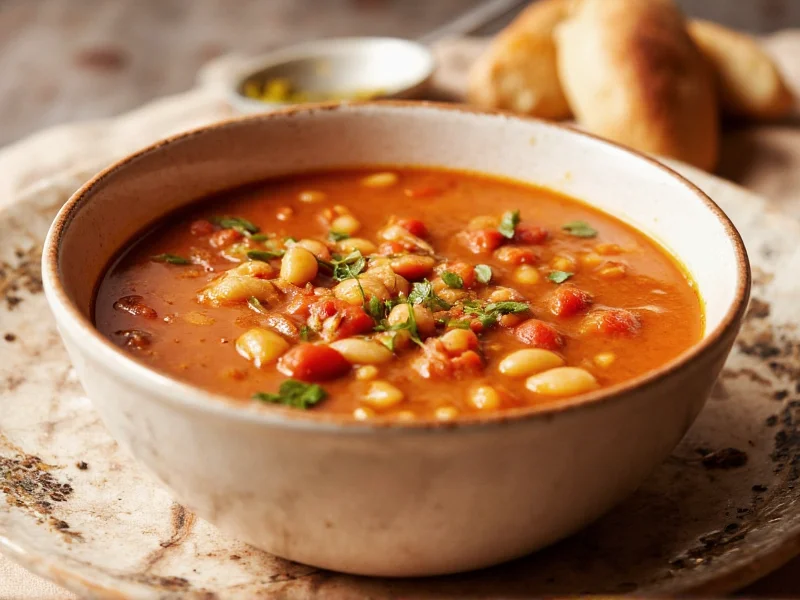For centuries, Tuscan bean soup has nourished families across Italy's countryside. This humble dish embodies cucina povera—the Italian tradition of transforming basic pantry staples into deeply satisfying meals. Unlike Americanized versions featuring sausage, authentic Tuscan bean soup relies solely on vegetables, legumes, and aromatic herbs for its rich flavor profile.
The Essence of Authentic Tuscan Bean Soup
True Tuscan bean soup originates from farmhouse kitchens where ingredients were limited but creativity abundant. The classic combination of cannellini beans, lacinato kale (cavolo nero), tomatoes, and aromatic herbs creates a naturally creamy texture without dairy. This plant-based preparation reflects Tuscany's agricultural heritage where meat was historically reserved for special occasions.
What distinguishes an authentic fagioli alla toscana from imitations? Three critical elements:
- Bean selection: Only creamy cannellini beans provide the proper texture
- Leafy greens: Traditional lacinato kale (not curly kale) offers the right bitterness balance
- No meat: Authentic versions contain no sausage or pancetta
Essential Ingredients for Perfect Tuscan Bean Soup
Quality ingredients make or break this simple dish. Here's what you'll need for an authentic experience:
| Ingredient | Why It Matters | Substitution Options |
|---|---|---|
| Dried cannellini beans (1 lb) | Creates superior texture and creaminess compared to canned | 2 (15oz) cans, drained (reduce cooking time by 45 minutes) |
| Lacinato kale (1 bunch) | Traditional bitter-sweet flavor profile | Curly kale (more bitter) or Swiss chard |
| Extra virgin olive oil (¼ cup) | Essential for authentic flavor base | None (critical to authenticity) |
| Fresh rosemary (2 sprigs) | Distinctive herbal note | 1 tsp dried rosemary (less potent) |
| Tomato passata (2 cups) | Smooth tomato foundation without chunks | Crushed tomatoes (slightly chunkier texture) |
Step-by-Step Preparation Guide
Follow these steps for an authentic Tuscan bean soup that captures Italy's culinary spirit:
Bean Preparation (Overnight)
- Rinse 1 pound dried cannellini beans, removing any debris
- Soak in 3 quarts cold water with 1 tablespoon baking soda (helps digestion)
- Refrigerate for 8-12 hours
Soup Assembly (1 hour)
- Drain soaked beans, rinse thoroughly
- In 5-quart pot, heat olive oil over medium heat
- Add 1 chopped onion, 2 minced garlic cloves, and 1 diced carrot
- Sauté until softened (5-7 minutes)
- Add drained beans, 6 cups vegetable broth, and rosemary sprigs
- Bring to gentle boil, then reduce heat to low
- Cover and simmer for 45-60 minutes until beans are tender
- Stir in tomato passata and chopped kale
- Cook uncovered for 15 more minutes
- Remove rosemary stems, season with sea salt and black pepper
- For creamier texture, blend 1-2 cups soup and return to pot
Professional Tips for Culinary Success
Elevate your traditional Tuscan white bean soup with these chef-tested techniques:
- Acidity balance: Add 1 tablespoon red wine vinegar at the end to brighten flavors
- Texture control: Reserve ½ cup cooked beans to add at the end for varied mouthfeel
- Flavor development: Sauté aromatics slowly—never let garlic brown
- Bean quality: Source Italian-grown cannellini beans when possible
- Resting time: Let soup sit 20 minutes before serving for flavors to meld
Variations for Dietary Needs
This adaptable recipe accommodates various preferences while maintaining authenticity:
- Slow cooker method: After sautéing aromatics, transfer everything to slow cooker and cook on low 6-8 hours
- Vegan adaptation: Already naturally vegan—ensure broth is vegetable-based
- Gluten-free: Naturally compliant (verify broth ingredients)
- Lower sodium: Use low-sodium broth and increase herbs for flavor
- Extra protein: Stir in ½ cup cooked farro during last 10 minutes
Serving Authentic Tuscan Style
In Tuscany, this soup traditionally serves as a primo piatto (first course). For an authentic experience:
- Drizzle each bowl with high-quality extra virgin olive oil
- Serve with crusty bread for dipping (fettunta)
- Pair with a simple green salad dressed in lemon vinaigrette
- Offer freshly grated Pecorino Toscano on the side (optional)
- Enjoy at lunchtime—the traditional Italian meal when this soup appears
Storage and Reheating Instructions
Tuscan bean soup improves with time as flavors develop:
- Refrigeration: Store in airtight container for up to 5 days
- Freezing: Portion into freezer bags (lay flat) for up to 3 months
- Reheating: Warm gently over medium-low heat, adding broth if too thick
- Revitalizing: Stir in fresh kale and a splash of vinegar when reheating
Why This Recipe Works
Unlike many online versions, this authentic Tuscan bean soup recipe respects regional traditions while delivering maximum flavor through technique rather than shortcuts. The slow simmering develops complex flavors naturally, while the careful balance of bitter (kale), sweet (carrot), and savory (beans) creates a satisfying harmony. This easy Tuscan bean soup from scratch proves that simple ingredients, treated with respect, yield extraordinary results.











 浙公网安备
33010002000092号
浙公网安备
33010002000092号 浙B2-20120091-4
浙B2-20120091-4